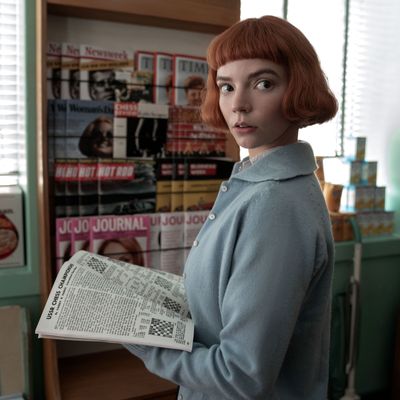
The first time Beth Harman appears in the absorbing new Netflix series The Queen’s Gambit, she is sopping wet, fully clothed, and in a bathtub after what appears to have been a night of drinking and, possibly, some semi-debauchery. An unseen person, presumably a lover, is still sleeping beneath Beth’s hotel bed sheets. The remains of Beth’s mascara are streaked across her face. And as a knock at the door reminds her, she is wildly late for exactly the sort of thing one would expect a woman living a seemingly rock-and-roll lifestyle to be late for: a high-stakes chess match.
By beginning at this moment, in 1967, when Beth is about to play a clearly accomplished Russian opponent, The Queen’s Gambit announces two things: that Beth is an elite chess player and that she has some habits that threaten to sabotage that status. From there, the series, co-created by Allan Scott and Scott Frank, creator of Godless, flashes back several years to Beth’s childhood and the moment that she became an orphan, following her mother’s death in a car crash. Young Beth (Isla Johnston) is taken to the Methuen Orphanage for Girls where she begins to learn the game of rooks and pawns by playing with Mr. Shaibel (Bill Camp), the gruff custodian who becomes her mentor. In the orphanage basement, while leaning over a basic chessboard, a future star is born.
The seven episodes of The Queen’s Gambit are basically a portrait of the chess prodigy as a young woman, following Beth from girlhood in the 1950s to adulthood in the late 1960s, when she’s long since traded her blunt bob for a flip do that makes her look like the Emma Peel of the chess world. It is a great blessing that, from her teenage years onward, Beth is played by Anya Taylor-Joy, star of The Witch, the most recent Emma., and, soon, the Mad Max: Fury Road prequel. As an awkward, emotionally stunted teen, Taylor-Joy gives Beth physical gestures and a vocal intonation as purposeful and blunt as a checkmate. But as she moves into womanhood, she begins to carry herself with more grace. As the only woman competing in a male-dominated realm, Taylor-Joy emphasizes the femininity that Beth brings to each face-off, often lacing her fingers together and resting her chin upon them between moves in a way that is simultaneously girlish and intimidating.
And then there are Taylor-Joy’s eyes. Her eyes are enormous, infinite vessels of expression. They are larger than planets, larger than galaxies, so large that she makes traditional animated Disney princesses look as if they’re squinting. If you could somehow take Emma Stone’s eyes and supersize them, you would still wind up with a pair of peepers only one-third the size of Anya Taylor-Joy’s eyes, at best. They are one of her greatest assets as an actor. Beth’s opponents generally lose to her because she’s so naturally skilled at chess. But they, and pretty much anyone else she comes in contact with, may also be disconcerted by the force of the gaze that emanates from those colossal optic orbs.
The Queen’s Gambit, adapted from the novel by Walter Tevis, obviously focuses quite heavily on chess, a game that can be a bit dull, especially to those who don’t fully understand its rules. But Frank, who wrote and directed every episode, finds consistent ways to make it exciting, even a bit sexy. We are led to believe that Beth is a natural chess genius in part because she has an aptitude for math, but also because of an almost mystical ability to see chessboards and pieces in the shadows that ripple across her ceiling when she goes to sleep each night. There’s something dreamlike and mesmerizing about these visions, rendered via visual effects.
The many tournaments that Beth competes in proceed at brisk paces — it helps that Beth is an intuitive player who, generally, doesn’t overthink her moves — and Frank adds certain flourishes to differentiate them from each other. The majority of one tournament flies by via a rotating split-screen montage that unfolds to “Classical Gas.” In another extremely high-pressure showdown, the sound of the play clock is amplified, giving the scene an almost frantic cadence.
As the opening scene of the series suggests, The Queen’s Gambit is as much about addiction and the suppression of pain as it is about chess. Shortly after young Beth arrives at the orphanage, she is given a daily dose of tranquilizer, a dangerous way for the staff to make sure the girls stay calm and controllable. Because Beth’s visions begin to manifest at that time, she believes that her chess magic is inseparable from the meds. She eventually adds alcohol to the mix; where the pills open her mind, it seems the wine and liquor wash away her feelings of abandonment and inadequacy.
With four episodes that run for an hour or more, The Queen’s Gambit sometimes spends more time on certain story lines than it should. Every moment spent on the relationship between Beth and her adoptive mother, Alma Wheatley, played by director Marielle Heller (A Beautiful Day in the Neighborhood, Can You Ever Forgive Me?) in a gentle and appropriately sad performance, is a valuable look at a relationship in which both parties enable and show forgiveness to each other. Some of Beth’s romantic, or quasi-romantic, entanglements aren’t as thoughtfully considered given how much screen time they command. The final episode also takes on an almost It’s a Wonderful Life quality that’s out of step with the tone of the rest of the limited series.
But The Queen’s Gambit is still largely satisfying anyway, as a handsome-looking period piece, another showcase for Taylor-Joy’s talents (and her eyes), and a consideration of anxiety, unprocessed trauma, and how both can so easily conspire to drive a genius in the opposite direction of her dreams.


